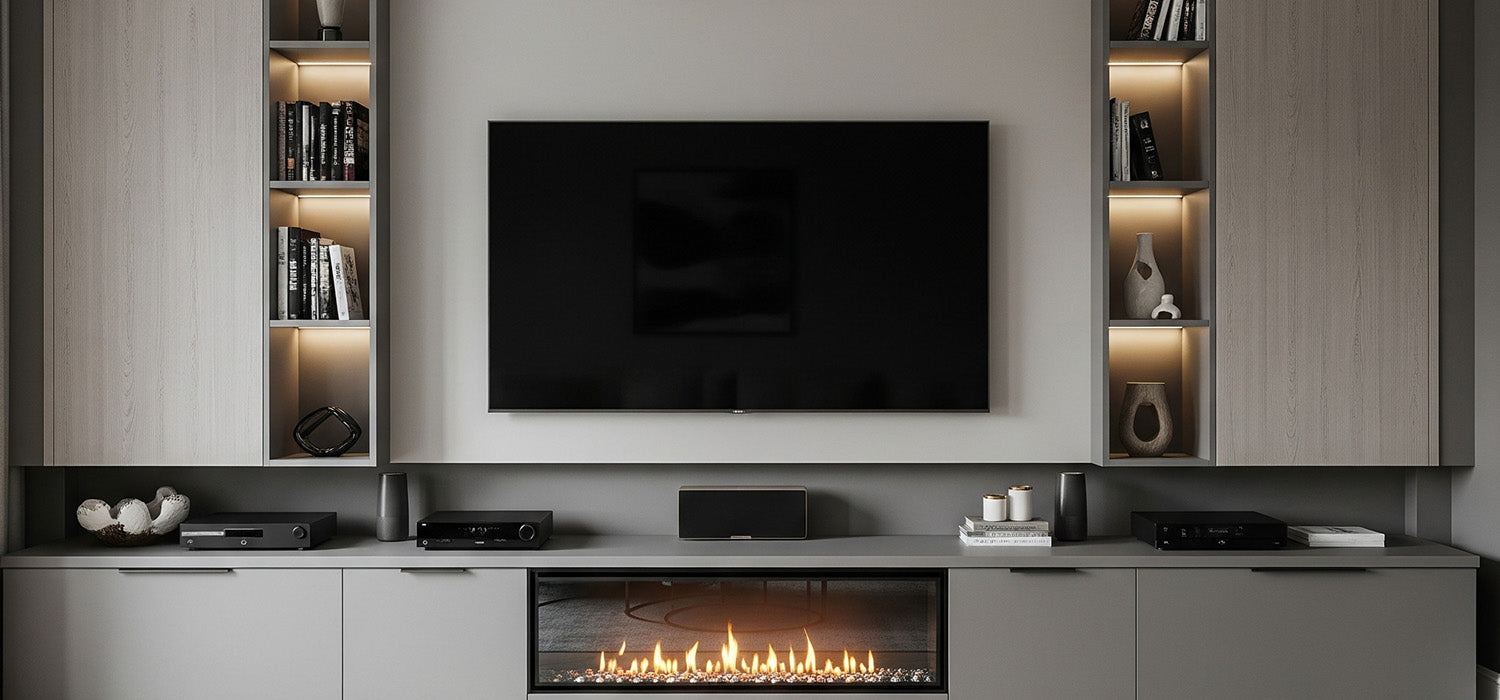
Media Wall with Cabinet: The Smart Way to Hide Your Wires
Short answer? A media wall with cabinet is where style meets storage—and yes, it hides your mess beautifully. From sleek units to cosy Media Wall Fire setups, this living room hero does it all. Want clutter-free cool with serious wow-factor? Keep reading—we’re unlocking your wall’s hidden superpowers.
Why Effective Cable Management is Crucial for Your Media Wall
You’ve just had your dream media wall installed. The big telly’s up, the flames of your Media Wall Fire are dancing, and your cabinet looks spot on. But hang on—why are there cables dangling like jungle vines?
Cable management is the not-so-glamorous backbone of every impressive media wall. Without it, your high-end design can quickly look like the back of a budget electronics shop. Let’s break down why it matters so much—and how to get it right.
Enhancing Aesthetics and Visual Appeal
We all love a good-looking space, and nothing ruins a sleek setup like rogue wires creeping out the corners.
Eliminating Unsightly Wire Clutter
It’s hard to feel relaxed when your eye keeps catching tangled cords. A neat cable setup immediately lifts the room, helping your media wall stand out for all the right reasons.
Plus, it’s easier to keep clean when there’s not a nest of wires collecting dust under your unit.
Achieving a Seamless, Professional Finish
Ever seen those living room photos on Pinterest or Instagram? Chances are they all had one thing in common—no visible wires.
Clever cable routing gives your space a custom-built, high-end look, even if you DIY’d it on a tight budget.
Improving Safety and Preventing Hazards
Yes, cable clutter looks messy—but it can also be a real safety concern.
Reducing Tripping Risks
Trailing wires are an accident waiting to happen, especially in busy family homes. Pets, kids, or guests could easily trip, yank equipment down, or worse.
Tucking cables neatly away isn’t just stylish—it’s smart.
Protecting Cables from Damage
Squashed behind furniture, tangled up with power plugs, or being stepped on—unprotected cables don’t last long.
Neat cable runs keep your gear in top shape, helping you avoid connection issues, sound dropouts, or sudden losses of power.
Optimising Equipment Performance and Lifespan
Your devices deserve better than sitting in a hot, cramped, tangled mess.
Preventing Overheating by Ensuring Airflow
Overheating is a silent killer of electronics. Tidy cable layouts leave breathing room around your Sky box, PlayStation, or soundbar.
Ventilation isn’t optional—it’s essential if you want your kit to keep running smoothly.
Ease of Access for Maintenance and Upgrades
Planning on upgrading your console? Switching to a faster router? You’ll thank yourself later for labelling and organising your cables now.
No need to dismantle your whole setup when it’s easy to identify and access each lead.
Understanding Your Cable Management Options
Managing cables isn’t one-size-fits-all. Depending on your wall structure and setup, you’ve got several neat options to choose from.
In-Wall Concealment
If you’re building a media wall from scratch—or you’re happy drilling into plasterboard—concealing cables inside the wall is the cleanest approach.
Recessed Power Outlets and Low-Voltage Boxes
Installing power and data ports flush inside the wall keeps things sleek and safe. No bulky plugs or messy trailing sockets.
Conduit and Cable Tubes Behind the Wall
These create a protected pathway from your cabinet up to your telly. Ideal for feeding HDMI, speaker, or ethernet cables without damaging walls during future changes.
Brush Plates and Wall Pass-Throughs
Brush plates let your cables slip in and out of walls without leaving gaps. A tidy finish for anyone who wants wires hidden but accessible.
On-Wall Management
Great for renters or existing builds where wall-chiselling isn’t an option.
Cable Raceways and Covers
These clever covers stick to your wall, hiding cables in plain sight. Most are paintable, so they blend right into your decor.
Adhesive Clips and Cable Ties
Simple, cheap, and surprisingly effective. Stick-on clips and ties let you run wires behind furniture or under shelving without permanent fixes.
Integrated Media Furniture Solutions
Let your cabinet do the heavy lifting.
Cabinets with Cut-Outs and Ventilation
Modern media units often include smart features—hidden cable gaps, ventilation panels, even built-in plug trays. Perfect for hiding clutter while keeping everything cool and tidy.
Shelving with Built-In Channels
Some shelves come with secret grooves that guide your cables like a track. A tidy solution that looks clean from every angle.
Tools and Essentials to Make It Happen
Before you start threading wires, you’ll need a few things to make life easier.
Cable Management Kits
These handy bundles usually include clips, sleeves, zip ties, and wraps. Everything you need to get started in one go.
Wall Plates and Cable Inserts
HDMI, speaker, and ethernet inserts make things look clean and let you connect without cable spaghetti hanging out the back.
Power Strips with Surge Protection
Essential for protecting expensive electronics. Choose one with a decent cable length and enough space for chunky plugs.
Cable Ties and Sleeves
Velcro ties are perfect for adjusting later. Sleeves help group cables neatly together so they’re easy to hide behind furniture.
Basic Tools: Drill, Tape Measure, Stud Finder
If you’re going in-wall, you’ll need to know what’s behind that plasterboard. Always measure twice—cut once!
Planning Your Cable Management
Start with a plan, not a panic.
Map Out Your Connections
List every device—TV, soundbar, console, router, fire feature. What connects to what? Which need power? Which need HDMI or internet?
It’s much easier to manage when you’ve mapped it all out.
Choose In-Wall or On-Wall
If you want a clean, showroom finish and you're confident with DIY (or hiring a pro), go in-wall. Otherwise, on-wall methods offer similar results with less commitment.
Measure Everything
Know your TV height, cabinet dimensions, and outlet locations. Get those spots wrong, and you could be looking at re-drilling or re-routing cables later.
Ventilation Counts
A cabinet full of kit can heat up fast. Plan for air gaps, mesh panels, or even cooling fans if you're running a full entertainment suite.
Tips for a Smooth Installation
Keep it simple, keep it safe.
Route Safely
Always avoid existing wires and studs. Use a stud finder and plan carefully—don’t just guess and drill.
Leave a little slack in your cables too. Too tight, and you'll struggle with changes later.
Label Everything
Seriously. A bit of masking tape and a pen will save you hours of guessing which wire goes to what when something stops working.
Avoid Pinching or Crushing Wires
Don’t trap them behind heavy units or force them around tight corners. Damaged cables can lead to poor connections—or even electrical faults.
Test Before You Tidy
Make sure everything works before you box it all in. No one wants to undo a perfect finish because the HDMI wasn’t pushed in properly.
Troubleshooting the Usual Suspects
Problems happen—but most are easy to fix with a few smart adjustments.
Too Many Wires?
Use HDMI switchers, power hubs, or tidy cable sleeves to cut the chaos. Also, be honest—do you still need that DVD player?
Heat Buildup?
If your cabinet feels like a sauna, add ventilation holes or leave doors slightly ajar when gaming or streaming. Keeping your tech cool keeps it alive.
The Bottom Line: Your Wall, Your Way
A media wall with cabinet doesn’t just house your telly—it brings your living room to life.
But without proper cable management, it quickly becomes a tangle of frustration. With a bit of planning and a few clever tricks, you can keep things cool, clean, and under control.
So go on—create that perfect Media Wall Fire feature. Tidy cables, happy life.

